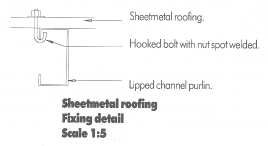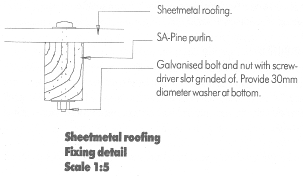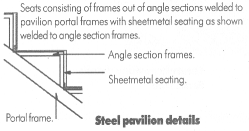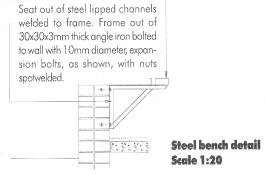Design
Design with “vandalism” and “frequent use” in mind. Careful attention should be given to design details and the use of appropriate building materials to achieve a durable basic indoor sports facility.
|
 |
WALLING
The walls of brick structures ought to be build of standard clay bricks or of standard cement bricks , both of which are freely available on the market. Bricks manufactured by larger brick companies will normally be of the correct compressive strength of 7Mpa for
General building work. However , when manufacturing cement bricks, care must be taken to ensure the quality and standard to meet the compressive strength criteria.
Before using self-made bricks, samples should be sent for compressive strength tests to a laboratory. These may be found in all major centers. Mortar mixes for brickwork should contain 50kg cement to 200 of sand. Foundations for walling must conform to normal building practice regarding founding layers, i.e. excavations shall be dug down onto solid formations and mixes for concrete strip footing for single storey structures shall be 1 part cement for 3 parts sand to 5 parts stone.
By ensuring that standard building practices are applied when doing the brick works, less cracks will become evident after completion of the structure and quality will not be compromised . For low maintenance, the use of face bricks semi-face bricks or even stock bricks built fair and pointed with recessed horizontal and vertical joints should be encouraged. The will also discourage the painting of slogans on the walls. This type of finish is very successful inside ablution facilities and change rooms.
Maintenance
Brick normally requires little maintenance and repairs.
PLASTERING
In certain instances plaster can be omitted from building with joints of brickwork (stocks or facings) neatly pointed. This enhances maintenance but will give a “rougher” finish. Cement plaster should be composed of 1 part cement to 5 parts sand for durability.
Maintenance
Repairs to damaged portions (intentional abuse) and “hollow” areas must be done in the following manner: Remove the damaged or hollow area prepare wall by cleaning and preparing a plaster “key” by either roughing the surface with a sharp tool or by applying a cement / sand slush to serve as a “key” and then plaster the prepared area with a 1 part cement and 5 parts sand plaster mix.
ROOFING
In coastal regions roof sheeting for basic facilities needs to be specially treated with anti-corrosion compound or can be of a different material, e.g. fibre cement. Please note that fibre cement by nature is very brittle with the result that the odd stone thrown onto a roof could easily result in the replacement of a full sheet.
Due to budget constraints galvanized roof sheeting is generally used inland.
The
following measures may be applied to
complement security:

EXAMPLE: Hook bolts to steel
purlins

Click pic for larger image.

EXAMPLE: Bolting down sheeting through
timber purlins
Protecting
bolts against rust through galvanising or
painting would be necessary.

Click pic for larger image.

EXAMPLE:
Secure sheeting by means of a steel
longitudinal bar (galvanised or painted
against rust)

Click pic for larger image.
GUTTERS, DOWN PIPES, FASCIAS
The type of gutters and down pipes will be determined by the materials used for the materials used for the roof covering, climatic conditions etc. e.g. fibre cement may be used in coastal regions.
If necessary, down pipes can be omitted when erecting very basic facilities and substituted with spouts. In such cases care should be taken to provide concrete aprons underneath spouts to prevent ground erosion. Loose precast concrete slabs or tiles might not suit this purpose as these can be removed too easily.
If utilised, it is advisable that gutters and down pipes of galvanized sheet iron in lieu of PVC be utilised, as fixing details can be made more secure through special brackets (see below) and due to the superior durability of sheet iron versus
PVC.

Click pic for larger image.

Click pic for larger image.
PAVILION
STRUCTURES
In constructing pavilions special attention
should be given to seating details. It
is advisable to manufacture smaller movable
pavilions out of structural steel: 
EXAMPLE:
Pavilion Structures

Click pic for larger image.

EXAMPLE: Larger fixed pavilions may
sport the following seating:

Click pic for larger image.
|
|

|
Maintenance:
Timber seating should be avoided due to
maintenance problems and fixing details.
|
New steel
structures ought to be painted to the
specifications as described under "Painting". Inspect
steel structures at six month intervals for
the appearance of rust and touch up
according to the specifications as described
under "Painting". 
EXAMPLE: Seating for concrete pavilions
must be simple

Click pic for larger image.
Large
stadiums will have more luxurious seating
details not applicable to the study. BENCHES
IN CHANGE ROOMS
Due to the extensive wear and tear which
change room seating is exposed to, the
design must be as simple and sturdy as
possible e.g.

EXAMPLE: Concrete Bench 
Click pic for larger image.

EXAMPLE: Steel Bench

Click pic for larger image.
|
|

|
Maintenance:
Concrete benching requires low
maintenance. Where steel and timber
slatted benches are installed, bench
brackets should be inspected weekly and
loose espansion bolts ought to be tightened
or replaced as any movement will compound
the pace of deterioration of seating.
|
LOCKERS IN
CHANGE ROOMS
Change room lockers must be fixed securely
to either the floor or a wall, e.g.: 
EXAMPLE: Lockers

Click pic for larger image.
CEILINGS
High building practice standards should be applied in the construction of ceiling as this will enhance durability. Generally gypsum plaster board will suffice, but care should be taken to install fibre cement board ceiling plates in areas exposed to steam (as in e.g. showers) Matching cornices must also be installed. Ceiling space for maintenance purpose s.
Maintenance
Regular inspections of ceiling after thunderstorms should reveal any signs of roof leakage generally appears at ridges, at flashings against side or head walls or due to loose fixing screws.
FLOOR COVERINGS
For low maintenance purposes floor coverings generally recommended are vinyl tiles, floated concrete, granolithic finish or ceramic tiling depending on the requirements for the areas concerned.
Maintenance:
Vinyl tiled floors: regular cleaning with a wet rug. Avoid washing with large quantities of water as water can penerate joints resulting in the lifting of tiles. Should idt be necessary to replace vinyl tiles, the previous tile glue must be removed before standard tile glue is applied and new tiles laid.
· Floated concrete and granolithic. Wash with detergent and water.
· Ceramic tiling: Wash with detergent and water. This applies especially to showers where algae can successfully be removed by scrubbing with water containing chlorine.
IRONMONGERY
Ironmongery (locks, barrel, bolts, hooks, etc.) generally must be of durable quality and, it must be of a material that suits the position of use, e.g. small quality and, barrel bolts at toilet doors in change rooms in basic facilities are unsuitable , as doors tend to be opened without slipping the catch resulting in damage to doors. A roller catch which allows doors to open freely would be more suitable.
Clothing hooks
The standard off-the- shelf chromium plated clothing hooks secured by two or four screws are usually easily removed or broken off and should be substituted by a more durable e.g. a well designed system will also be suitable for up-market larger stadiums.

EXAMPLE: Coat Hook

Click pic for larger image.
Toilet Paper Holders
These should be of stainless steel and bolt (expansion bolts) to walls. Screws are not durable.
Protection of Locks
Padlocks on fencing gates or steel security gates used at outside doors tend to be broken open with crowbars – the solution is to protect the lock in such a way that a crowbar cannot be inserted.

EXAMPLE: Security gate locks

Click pic for larger image.
|
|

|
Maintenance:
The immediate replacement of defective locks
is a necessity and regular inspections
should be carried out on hooks, etc. to
prevent further damage and deterioration.
|
PLUMBING
Plumbing piping is available in various materials, e.g. cast iron, galvanized mild steel, copper, uPVC and HDPe and all have different fixing methods and durability qualities.
In smaller facilities with lower security levels and where piping is exposed to spectators and player the following is suggested.
· Drain and vent piping exposed and above ground : Cast iron .
· Sanitary waste piping exposed and above ground: Galvanized mild steel.
· Water piping exposed above ground: Galvanized mild steel
Although the above system are more traditional and also more expensive, they are all of a durable material and with sturdy fixing details. The same result can be obtained by chasing piping in the more affordable systems like copper and PVC into brick walls and to keep exposed piping to a minimum.
The latter two systems are currently more popular. These should be installed in roof spaces, chased into walls, and used in ducts or areas with low exposure to the public as their fixing details and material is not as durable as the more traditional systems.
Sanitary Fittings
Sanitary fittings, toilets, wash hand basins, urinals, etc. are generally available in the following materials:
· Vitreous China
· Ceramic fireclay
· PVC
· Rotomoulded polyethelene
· Stainless steel.
The choice of material shall depend on the following:
· Prestige
· Conceptual acceptability
· Cost
· Security
· Durability for frequent use.
A mistake frequently encountered in designs of low cost facilities is that of specifying cheap fittings e.g. toilet seats and cisterns of PVC which is by nature flimsy, cannot be fixed properly and as a result is damaged or breaks very easily. This then sets a pattern of vandalism in motion which is difficult to control.
Hints
In designing or maintaining ablutions or change rooms the following apply:
· Do not save by specifying cheap fittings as maintenance becomes very costly.
· The more expensive materials are also generally more durable.
· Design for frequent use not for low cost.
· Systems must be designed with rodding and inspection eyes for quick and regular cleaning as well as with the correct gradients to keep blockages to a minimum.
· Always fix cisterns and bracket with expansion bolts in lieu of wooden plugs and screws.
· Always fix cisterns and brackets with expansion bolts in lieu of wooden plugs and screws.
Maintenance
· Blocked drains can be rodded through cleaning eyes in pipes provided for this purpose . Rodding equipment (a set of high tensile steel wires) is available from plumbers or municipalities or can be bought at suppliers of building materials.
· Repair leaking pipes immediately as water will damage paint, floor covering and brickwork.
· Leakages at geysers must be repaired immediately as the damage caused by 150 to 250 litres of water to ceiling and floors can be substantial. A frequent problem with geysers is the failure of the pressure reducing valve. This valve must be replaced when slight leakages occur.
Hint
Always remember to switch off the electric power supply to the geyser for safety purpose before attempting to inspect a leakage.
ELECTRICAL INSTALLATIONS
Electrical designing for basic and indoor sports facilities must include the following:
· All plug points must be protected by earth leakage systems.
· If budgets allow, all light fittings must be vandal proof Class 1 Division 1.
· All light fittings must be easily accessible for maintenance purpose.
Maintenance
· Public telephones are the responsibility to Telkom and any failures should be reported directly to Telkom.
· Do not overload plug points by adding additional equipment such as heaters, fan , urns, etc. by means of extension leads, as this will activate the earth leakage system with a resultant cut in the power supply.
Hints:
Should a power failure occur, the main circuit breaker in the main distribution board must be inspected to determine whether it is on or off. If switching to the “on” position is not successful, then the local maintenance electrician must be contacted to undertake the necessary repairs. No unauthorized persons should be allowed to access the main distribution board.
WINDOWS
Vandalism mainly revolves around breakages of glass panels. Various options exist.
· No glass in windows. This is only feasible in small panels. Various options drier areas of the country.
· Protect glass. Provide expanded metal screens in front of windows that still allow easy opening of the windows.

EXAMPLE: Burglar proofing

Click pic for larger image.
Maintenance
- Use a putty knife and careful remove the old putty from the broken window.
- Once all the front putty has been removed, carefully remove the broken window and then the remaining putty.
- Wipe the window frame with a damp cloth and then insert a thin layer of back putty all round the window frame.
- Install the new window pane into the frame and press the glass pane firmly against the back putty and then apply ample putty all round the pane.
- Take the putty knife and at an angle of 45 shape putty and remove all the excess putty. Trim putty also on the inside of the pane.
- On completion of the painting, clean the window both inside and outside, carefully so as not to upset the putty with finger marks.
Doors
The following options are available taking into account vandalism and maintenance.
Standard Sheet Metal Doors and Frames
These doors are very durable and are suitable as outside doors as well as inside doors for toilets in ablution facilities. All doors shall be treated with the correct coats of paint for protection against rust and to reduce maintenance costs.
Solid Meranti Framed Ledged and Braced Batten Door
Suitable as outside doors when protected with paint or varnish. If budget allows, these doors should also be used as inside doors to toilets because of sturdiness and durability.
Semi-Solid Wooden Doors
Suitable as inside doors not exposed to the elements. These doors are less expensive than solid timber doors but are not as durable and should preferably not be used as toilet doors in ablution facilities (Solid timber doors or steel doors are more suitable).
As a general rule, cheaper hollow core doors must not be used at all in basic facilities, as they are not suitable for public areas.
Frames should general be of pressed metal.
PAINTING
All painting should be done strictly in accordance with the manufacturer’s instructions regarding preparation of surfaces, undercoats and the proper finishing coats for specific surfaces. Durability strongly depends on the correct specifications, which are usually obtainable from any manufacturer of paint.
Point specifications for different surfaces:
Plastic Work
Previously painted plasterwork.
- Clean and remove loose and flaking paint by scraping with putty knife and thoroughly sanding with sandpaper until all loose paint has been removed.
- Wash down with sugar soap to remove all dirt and grease and rinse with clean water. Leave to dry out thoroughly.
- Fill up all cracks with interior Polyfilla and sand to a smooth and even surface.
- Remove all loose dust by brushing with a clean brush.
- Apply one coat universal undercoat.
- Apply two coats finishing paint (enamel, acrylic PVA).
- Ensure that the new paint is suitable for outdoor / indoor use as required.
New Plasterwork
- Fill up cracks and holes with interior Polyilla and sand to a smooth and even fininsh. Remove all loose particles and dust by brushing with a clean dry brush. Make sure all plasterwork is thoroughly dry.
- Apply one coat primer (bonding liquid.)
- Apply one coat universal undercoat
- Apply tow coats finishing paint (enamel, acrylic paint)
- Ensure that the new paint is suitable of outdoor / indoor use as required.
Maintenance:
In areas exposed to water and steam , it is advisable to use an enamel type paint (shower, bathrooms and kitchens)
Steel (Door and Window Frames)
Previously painted steel in bad condition.
- Remove existing paint by scraping or sanding or by using a paint stripper. When paint stripper is used , clean down.
- Remove all rust with emery cloth or rust remover.
- Clean thoroughly and remove all dust with a clean dry brush.
- Apply one coat metal primer
- Apply one coat universal undercoat.
- Apply two coats enamel paint.
Previously painted steel in good condition.
- Remove loose pint by scraping or sanding
- Remove all rust with emery cloth or rust remover
- Clean steelwork by washing down with sugar soap and rinse with clean water
- Remove all dust with a clean dry brush.
- Apply one coat universal undercoat
- Apply 2 finishing coats enamel paint.
New Steelwork
- Remove all grease and oil with a degreaser.
- Remove all rust with emery cloth or rust remover
- Clean steelwork by washing down with sugar soap and rinse with clean water
- Clean thoroughly and remove all dust with a clean dry brush.
- Apply one coat metal primer
- Apply one coat universal undercoat.
- Apply tow coats enamel paint.
Exterior Metal (Galvanized Gutter, Down Pipes, ETC)
Previously painted metal in bad condition.
- Remove paint by scraping or sanding or by utilising paint stripper.
- Wash down with sugar soap and rinse with clean water
- Clean thoroughly and remove all dust with a clean dry brush.
- Apply one coat calcium plumbate metal primer.
- Apply one coat universal undercoat.
- Apply tow coats enamel paint.
Previously painted metal in good condition
- Remove loose paint by scraping or sanding.
- Remove all rust with emery cloth or rust remover.
- Clean steelwork by washing down with sugar soap and rinse with clean water.
- Remove all dust with a clean dry brush.
- Apply one coat universal undercoat.
- Apply two finishing coats enamel paint.
New Metal
- All surfaces to be thoroughly scrubbed down with galvanized iron cleaner using proper clean brush.
- Rinse with clean water.
- Apply one coat calcium plumbate.
- Apply one coat universal undercoat.
- Apply two cats enamel paint.
Ceilings
Previously painted gypsum / fibre cement ceiling boards
- Remove all loose paint by scraping or sanding
- Clean thoroughly and remove all dust with a clean and dry brush.
- Fill all holes with Polyfilla and sand smooth.
- Apply one coat universal undercoat.
- Apply tow coats finishing paint (enamel in areas exposed to water and steam: kitchens, bathrooms, showers).
New Ceiling
- Remove all dust by brushing with a clean and dry brush.
- Apply one coat primer
- Apply one coat universal undercoat.
- Apply 2 finish coats (enamel in areas exposed to water and steam)
Timber
Previously varnished timber
- Sand down properly with sand paper
- Fill all cracks with wood filler and sand smooth.
- Remove all dust with clean dry brush.
- Apply two coats varnish.
New timber to be varnished
- Sand smooth
- Remove all dust with a clean dry brush.
- Apply 3 coats varnish.
Previously painted timber
- Remove all loose paint by scraping and sanding
- Fill cracks with wood filler and sand smooth
- Remove all dust with clean, dry brush.
- Apply one coat universal undercoat.
- Apply two finishing coats (enamel)
New timber to be painted
- Sand smooth
- Apply primer coat
- Apply one coat universal undercoat
- Apply tow finishing coats enamel.
Maintenance:
The maintenance budget must allow for painting as the deterioration of appearance invites vandalism.
|